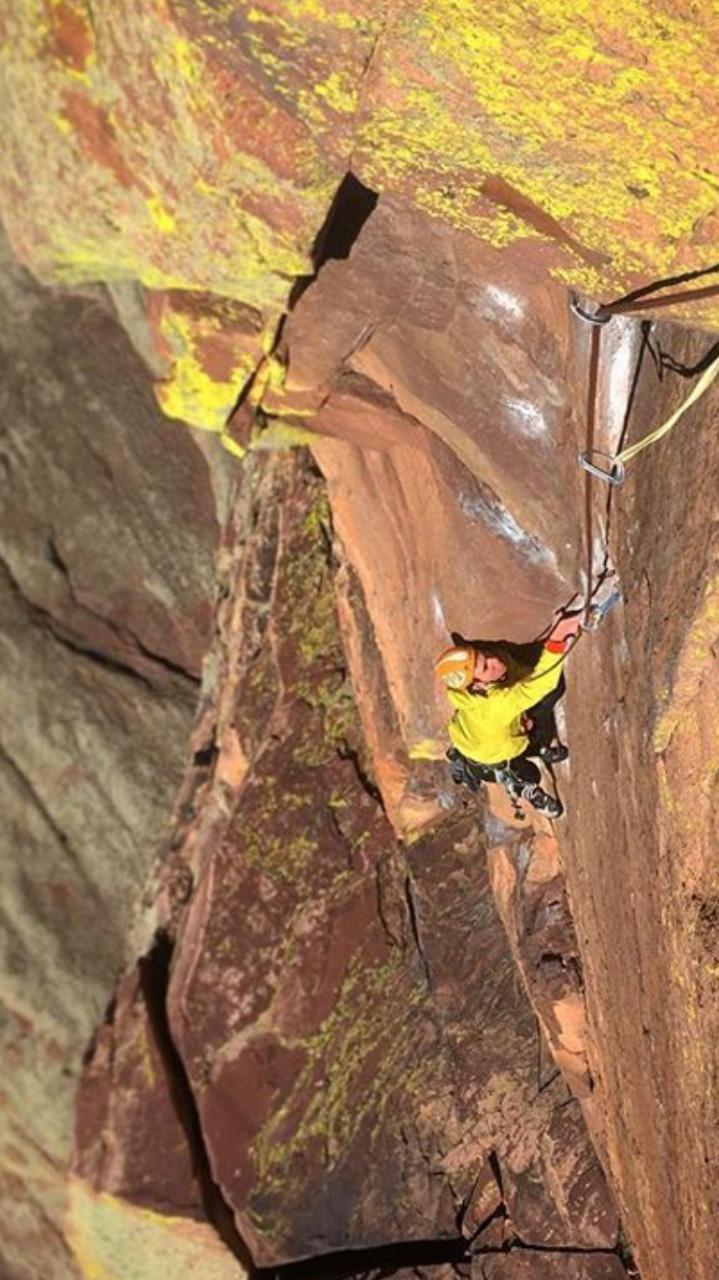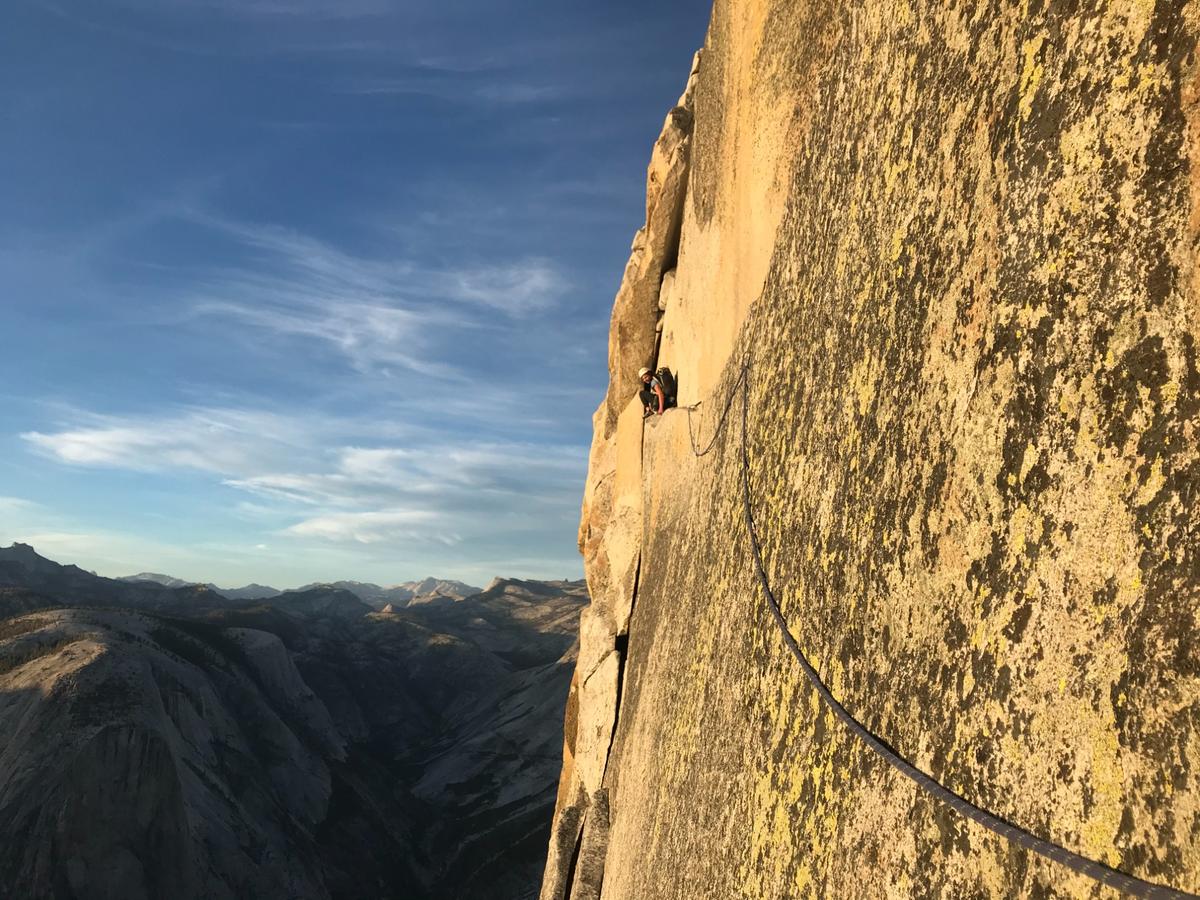MANSON FIRST CAME to Yosemite Valley at 17, en route to his first visit to Stanford. The rush from the Porch Swing at El Cap fueled his desire for a more formidable goal – the NIAD. Nose In A Day. An ultimate achievement for any climber.
Max reached out to Stanford physics student and rugby player Kara Herson to climb Half Dome’s Regular Northwest Face after the 2022 track season ended. Kara, daughter of Yosemite big-wall free climber Jim Herson, first ascended the RNWF when she was 12, and the Nose In A Day at 14.
Herson hadn’t climbed regularly and was a bit reluctant at first. Manson was in even worse climbing shape, having not climbed in months during the indoor and outdoor track seasons.
“He’s got some big goals out there, and he’s willing to get after it and try things that push his limit,” Herson said. “He’s definitely willing to be out of his comfort zone, to go and spontaneously try to do something that’s most people’s lifetime dream.”
The adventure began at 5 a.m. with a hike up the Death Slabs, a 2-3 hour approach to Half Dome’s face that’s notorious for loose rock. A goat trail of sorts zigzags across the broken ledge systems to the base of the wall.
The RNWF is not an especially long route – 20 pitches. A pitch is a steep section that requires a rope between two belays, as part of a climbing system. The leader climbs up, trailing the rope and clipping it into protection that they place along the way. They climb until they find a ledge to stop on or run out of rope, then build an anchor and belay their partner up. The partner removes the protection that the leader placed as they climb, so nothing is left behind. This process is repeated over and over for each pitch.
During the drive to Yosemite Valley, Manson and Herson discussed strategy and tried to foresee every possibility.
“On a route this long, something always goes wrong,” Herson said. “Nothing ever goes 100 percent to plan. Being able to think about it on the fly … There’s a lot of problem-solving involved.”
She was right.
A 2015 rockfall caused part of the route to fall away. In its place, a bolt ladder was installed. When they reached the top of that ladder, the final bolt was missing. The solution apparently was to lasso a block of granite 20 feet away, but they could not get the rope to catch, despite an hour or so of trying.
“So, we switched strategies,” Manson said. “I started leading up a different way, a 5.12 pitch on a route called Arcturas, which was harder than anything we expected to climb that day. From the anchor of that pitch, I was able to lower down and swing over to access the rope toss from a better position and we finally made it across.”
By this time, they had run out of water. Manson’s arms were tired and began cramping constantly.
“I exerted a ton of energy climbing the hard pitch on Arcturas, and my endurance was already bad since I basically hadn't climbed for the past six months,” he said.
“You really can’t panic up there,” Herson said. “Because it’s not useful. We were really dehydrated and trying this hard section. That’s where you have to be really honest with who you’re climbing with … How you’re doing when stuff gets a little tough. You need to be like, ‘Hey, I need you to take this next pitch.’”
Herson took the lead, “dragging me up the next few pitches to Big Sandy ledge,” Manson said. Unfortunately, a slow party had just started up the Zig Zags, a series of steep cracks that make up some of the harder climbing on the route. Max and Kara had no choice but to wait for a couple of hours on that ledge, parched and baking in the 95-degree heat.
“Fortunately, after the rest, I got a new burst of energy, and my arms stopped cramping as often,” Manson said.
They made their way up the last few pitches efficiently and were greeted with a spectacular sunset as they topped out, following the tourist cables over the summit to begin their descent. Given the choice between a faster return through the Death Slabs or a protracted route down the main eight-mile trail to the valley floor, Max and Kara realized they didn’t have the stamina or the proper vision for a night scramble over dangerous rocks. They chose the trail, tripping on a few tree roots along the way.
Encountering a river and without a filter, they drank ravenously in the dark, and never got sick from the untreated water. They reached the car at 1 a.m., closing out a 20-hour day.
For an encore, Max called Kara again as they approached this academic year. This time, the request was the Nose. In a day.
“This has been a dream route ever since I saw the climbing movies when I was a little kid,” Manson said. “I had spent so much time looking up route topos, I pretty much memorized the route by then.”
To climb El Cap in a day, rather than the 2-3 days that most require, means the climbing has to be fast and efficient. It takes an extra level of expertise.
Manson and Herson chose a rope system called “short fixing,” which allows them to move upward simultaneously with an anchor in the middle, rather than one at a time while the other belays.
“You don’t want to fall in this system because it’s a big fall,” Herson said. “If you’re only placing your gear every 20 feet, for example, you’re pretty easily looking at a 50-foot fall with rope stretch and everything. You can fall, but you don’t want to if you’re climbing in that style.”
Because of the heat, September is not ideal for a NIAD attempt, which made an early start imperative. Having learned from their Half Dome climb, they loaded up with water and reached the base at 3:30 a.m. Moving well, they scaled the first third with handlamps.
“Our goal was to get as high as possible before the sun hit the wall,” Manson said. “We were a little nervous and wondered if we'd be able to move fast enough, so we brought a second rope that would allow us to bail if we needed to. But as soon as we started, I knew we wouldn't need it.”
El Cap is unique because of pendulum pitches to traverse across large portions of rock. The massive King Swing was a significant barrier. All the progress from 1,000 feet of climbing comes to an abrupt dead end. The only answer is to swing 100 feet to the left – by running along the sheer rock wall with 1,000 feet of emptiness below. As the pendulum swing reaches its zenith, the climber grabs the edge of a crack. The climb continues from there.
It took a couple of tries and maybe a warmup swing or two, but the King Swing was successful. Max and Kara reached the top in 13 hours.
They made it there before the sun hit the wall, and reached Camp 4, the halfway point, in only five hours. The climbing becomes steeper and harder the higher up the wall and Manson began to fatigue. Herson, though, “was absolutely crushing it,” Max said, cruising up challenging steep cracks with ease.
The final pitch is a huge overhanging bulge of granite. Herson led to the summit and waited for Manson.
“Pulling through that bulge was one of the most memorable experiences of my life,” Manson said. “There's 3,000 feet of air beneath you, and you can see the entire wall below. The exposure and scale is so vast that your brain has trouble processing it. It almost doesn't look real.”
Manson paused for a few minutes to take in the view, before pulling over the lip to be greeted by a cheering Herson on the summit.
“One of my favorite climbing experiences ever,” he said.
Ignaczak didn’t know about the climb until days later.
“Deep down, I know those opportunities don’t come about too often,” Ignaczak said. “I can’t say I was particularly mad about it, but I probably gave him a look afterward.”
Manson acknowledges the danger, especially on big climbs or speed climbs. He said he doesn’t often get scared.
“You can choose safe routes, you can place more protection, and you can always bail if you aren’t feeling it,” Manson said. “As long as you’re making smart decisions along the way, you can mitigate the risk pretty well. But there are some days, like NIAD, where I make calculated decisions to take on higher risk.
“When engaging with the higher risk climbing, it's crucial to stay extremely focused and calm. I access this sort of flow-state, where everything feels very dialed in.
“The skill of being able to instantly switch into this state of mind has been a valuable tool in my pole vaulting and other parts of life. For example, If I'm at a pole vault meet and I'm about to take my third attempt at an important height, I don't really get nervous, and I lend that to mindfulness skills I learned from climbing.”
Amy, who is afraid of heights, sees what drives Max and what makes him happy.
“He can’t just look at nature, he wants to experience nature,” she said. “Whether it’s the crashing waves or the mountain, or the wind on top of the summit, or sunrise, or the rock on his fingertips … he needs his senses to experience nature, as loudly as they can. I don’t know how to even explain that.”
His parents can see Max as a teacher or college professor. He has so much passion for the things he enjoys and is excited to share them with others.
On Friday afternoon, April 14, Manson placed fourth in his division, jumping 17-4 ½ (5.30m) at the Mt. SAC Relays in Walnut, California. Afterward, Max convinced his parents to drive him 180 miles to Vandenberg Space Force Base in Lompoc for the launch of SpaceX Transporter-7.
At 11:48, just hours after his competition, Manson stood mesmerized as the Falcon 9 rocket lifted off into the night sky, leaving a lighted trail of liquid oxygen and kerosene in its wake.
Manson no longer is the eight-year-old soaking in the views on the summit of his first 14,000-foot peak, but as he stared into the stars as the rocket disappeared into the darkness, the sense of fascination felt very familiar.
There are mountains to climb, rockets to launch, rocks to examine, and bars to clear. But the wonder never goes away.



